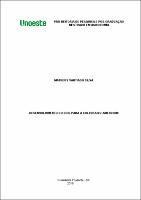| Compartilhamento |


|
Use este identificador para citar ou linkar para este item:
http://bdtd.unoeste.br:8080/jspui/handle/jspui/1151| Tipo do documento: | Dissertação |
| Título: | Desenvolvimento do DRIS para a cultura do amendoim |
| Título(s) alternativo(s): | Development of DRIS for peanut crop |
| Autor: | Silva, Matheus Santiago  |
| Primeiro orientador: | Creste, José Eduardo |
| Primeiro membro da banca: | Tiritan, Carlos Sérgio |
| Segundo membro da banca: | Hirata, Andréia Cristina Silva |
| Resumo: | O Sistema Integrado de Diagnose e Recomendação (DRIS), se apresenta como um método matemático que define faixas críticas e expressa valores nutricionais recomendados para uma cultura, assim esta ferramenta pode solucionar problemas de nutrição em plantas. O presente trabalho teve como objetivo elaborar as normas do DRIS para a cultura do amendoim (Arachis hypogaea L.) cultivar Runner IAC-886, na região de Guararapes-SP/Brasil. Os dados para realização deste trabalho, foram obtidos em área de renovação de canavial. As amostragens foram abrangidas por 112 parcelas com diferentes produtividades e realizado a análise química foliar (N, P, K, Ca, Mg, S, B, Cu, Fe, Mn e Zn). Determinou-se a população de referência (A) através do ponto de corte com produtividades de até 20% da produção máxima (≥ 4.367 e ≤ 5.458 kg/hectare) e o restante, definido como subpopulação (B) (≥ 2.519 e < 4.367 kg/hectare). Calculou-se as relações entre nutrientes na ordem direta e inversa (X/Y e Y/X). Após, foram calculadas as médias (XA e XB), os desvios padrões (DP A e DP B), as variâncias (S2A e S2B) e, suas relações (VA/VB), resultando em 110 relações nutricionais, mantendo as 55 maiores (direta ou inversa). Foi determinado índices para cada nutriente, onde, (+) excesso, (-) limitante e (0) balanceado. Determinou-se o Índice de Balanço Nutricional, sendo o melhor (21,8) pertencente a produtividade de 3.697 kg/ha. Definiu-se faixas críticas e valores nutricionais para cada nutriente avaliado. Concluiu-se que, o melhor IBN (21,8) foi da produtividade de 3,697 Kg/ha, o nutriente mais limitante no estudo foi o K e o mais excessivo o S. |
| Abstract: | The Diagnosis and Recommendation Integrated System (DRIS) is presented as a mathematical method that defines the critical linkages and expresses the recommended nutritional values for a culture, thus this tool can solve nutrition problems in plants. The aim of this study was to elaborate the DRIS norms for the cultivar Runner IAC-886 (Arachis hypogaea L.) in the region of Guararapes-SP / Brazil. The data for this work were obtained in area of sugarcane renovation. Samplings were covered by 112 plots with different productivities and the chemical leaf analysis (N, P, K, Ca, Mg, S, B, Cu, Fe, Mn and Zn). The reference population (A) was determined through the cut-off point with yields of up to 20% of maximum yield (≥ 4,367 and ≤ 5,458 kg / hectare), and the remaining defined as subpopulation (B) (≥ 2,519 and ≤ 4,367 kg / hectare). The relationships between nutrients in the direct and inverse order (X / Y and Y / X) were calculated. After that, the means (XA and XB), the standard deviations (DP A and DP B), the variances (S2A and S2B) and their relationships (VA / VB) were calculated, resulting in 110 nutritional relationships, and keeping the 55 (direct or reverse). The indices of each nutrient were determined, where (+) excess, (-) limiting and (0) balanced. The Nutrition Balance Index was calculated, and the best (21.8) belongs to productivity of 3,697 kg / ha. Critical ranges and nutritional values were defined for each nutrient evaluated. In conclusion, the best IBN (21.8) was of the productivity of 3,697 kg / ha, the most limiting nutrient in the study was K and the most excessive S. |
| Palavras-chave: | IAC-Runner 886, banco de dados, produtividade. IAC-Runner 886, database, productivity. |
| Área(s) do CNPq: | CIENCIAS AGRARIAS::AGRONOMIA |
| Idioma: | por |
| País: | Brasil |
| Instituição: | Universidade do Oeste Paulista |
| Sigla da instituição: | UNOESTE |
| Departamento: | Mestrado em Agronomia |
| Programa: | Mestrado em Agronomia |
| Citação: | Silva, Matheus Santiago. Desenvolvimento do DRIS para a cultura do amendoim. 2018. 48f. Dissertação (Mestrado em Agronomia) - Universidade do Oeste Paulista, Presidente Prudente, 2018. |
| Tipo de acesso: | Acesso Aberto |
| URI: | http://bdtd.unoeste.br:8080/jspui/handle/jspui/1151 |
| Data de defesa: | 14-Dez-2018 |
| Aparece nas coleções: | Mestrado em Agronomia |
Arquivos associados a este item:
| Arquivo | Descrição | Tamanho | Formato | |
|---|---|---|---|---|
| Matheus Santiago Silva.pdf | Matheus Santiago Silva | 1,24 MB | Adobe PDF |  Baixar/Abrir Pré-Visualizar |
Os itens no repositório estão protegidos por copyright, com todos os direitos reservados, salvo quando é indicado o contrário.




